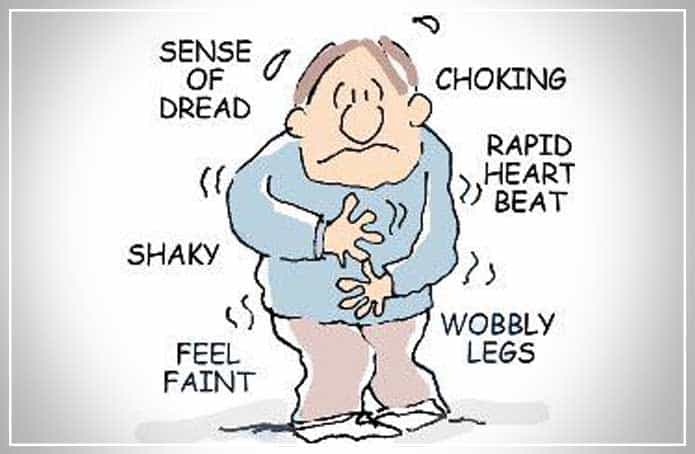There are many uneasy symptoms in the body through which one can identify self the problem one is suffering from. But as our, all the organ systems are well coordinated with each other so one can sense the similar symptoms for different disorders. For this exact problem existing in the body is very necessary to identify. Panic disorder is one of them.
The panic disorder should not be confused with other disorders as these attacks are the abrupt flow of intense fear or discomfort that peak within minutes. People with this disorder live in fear of having a panic attack. One may be having a panic attack when one feels sudden, overpowering terror that has no clear cause. One may experience physical symptoms, such as fast heartbeats, breathing difficulties, and sweating.
Most of the people experience a panic attack once or twice in their lives. The American Psychological Association reports that 1 out of every 75 people might experience a panic disorder. Panic disorder people live in the panic of getting panic attacks after the first experience.
The symptoms of this disorder can be quite crushing and frightening; they can be managed and improved with treatment. Looking for treatment is the most important part of reducing symptoms and improving the quality of life.
Panic Attack Symptoms
Panic disorder usually appears in teens and young adults under the age of 25. Symptoms of panic disorder often begin to. If one after getting the first panic attack lives in its fear of getting another attack then this becomes a panic disorder.
Panic attacks generate intense fear that begins suddenly, often with no warning. It typically lasts for 10 to 20 minutes, but in extreme cases, symptoms may last for more than an hour. The experience is different for everyone, and symptoms usually vary.
Common symptoms are:
Racing heartbeat or palpitations
Shortness of breath
Feeling like choked
Dizziness (vertigo)
Lightheadedness
Nausea
Sweating or chills
Shaking or trembling
Changes in mental state, including a feeling of unreality
Numbness or tingling in hands or feet
Chest pain or tightness
Fear that one might die
Causes of Panic Attack
The causes of a panic attack are not very clear but research has shown that panic disorder may be genetically linked, associated with significant transitions in life like leaving for college, getting married, or having a first child are all major life transitions that may create stress and lead to the development of the panic disorder.
People at Risk for Developing Panic Attack
It can be anyone but usually, women are twice as likely as men to develop the condition, according to the National Institute of Mental Health.
Diagnosis of Panic Attack
If one experiences symptoms of a panic attack, one may seek emergency medical care. Most people who experience a panic attack for the first time believe that they are having a heart attack, but this is different.
In any case, one may be asked to go for various blood tests to rule out other conditions that can cause similar symptoms, or an electrocardiogram (ECG) to check heart function. If one is normal in all the above conditions then it will be referred to as a mental health examination.
Panic Attack Treatment
Treatment for panic attacks focuses on reducing or eliminating the symptoms. This is achieved through therapy with a qualified professional and in some cases, medication. Therapy typically involves cognitive-behavioral therapy (CBT). This therapy teaches one to change their thoughts and actions so that one can understand attacks and manage their fear.
Panic Attack Medication
Medications used to treat panic disorder can include selective serotonin reuptake inhibitors (SSRIs), a class of antidepressants. SSRIs prescribed for panic disorder may include-
fluoxetine
paroxetine
sertraline
Some more medications to treat the panic disorder include:
serotonin-norepinephrine reuptake inhibitors (SNRIs), another class of antidepressant
antiseizure drugs
benzodiazepines (commonly used as tranquilizers), including diazepam or clonazepam
monoamine oxidase inhibitors (MAOIs), another type of antidepressant that is used infrequently because of rare but serious side effects
Panic Attack Home Remedies
In addition to these treatments, there are a number of steps that one can take at home to reduce their symptoms. Examples include:
Maintaining a regular schedule
Exercising on a regular basis
Getting enough sleep
Avoiding the use of stimulants such as caffeine
Panic Attack Prevention
Though there is no treatment for the panic attacks but can be prevented by one by avoiding alcohol and stimulants such as caffeine as well as banned drugs. It is also helpful to notice if one is experiencing symptoms of anxiety following a distressing life event, if one is bothered by something that they had experienced or will be exposed to, and then it is always advised to discuss immediately with a primary care providers.








Thanks for this. I guess I’m one of the 3 percenters that has panic disorder. Such an elite group!